Abstract
1. A study of the effect of changes in the hepatic portal venous pressure (HPVP) on the rate of urine flow in dogs has been made. Normally this pressure varies between 3·7 and 14·9 cm H2O. It can be raised or lowered by varying the method of manipulation of the visceral organs.
2. When the HPVP was raised within 15 cm H2O above the premanipulation level it caused an increase in urine flow to 2-3 times the normal levels within 2-5 sec. If the HPVP was raised to more than 15 cm H2O above the pre-manipulation levels it resulted in a period of antidiuresis. The urine flow returned rapidly to normal level immediately after the pressure was released.
3. The kidney volume increased when an induced diuresis occurred and decreased when an antidiuresis occurred.
4. The urine chloride concentration decreased during diuresis, but total chloride excretion increased. Total chloride excretion was reduced when an antidiuresis occurred.
5. Topical application of local anaesthetics at the hilus of the kidney and on the renal nervous plexus abolished the response. This and other evidence indicate that this effect on urine flow is a result of nervous reflex activity, probably involving the sympathetic but not the vagus.
6. The receptive area lies in the mesentery between the mesenteric capillaries and the main portal vein.
Full text
PDF

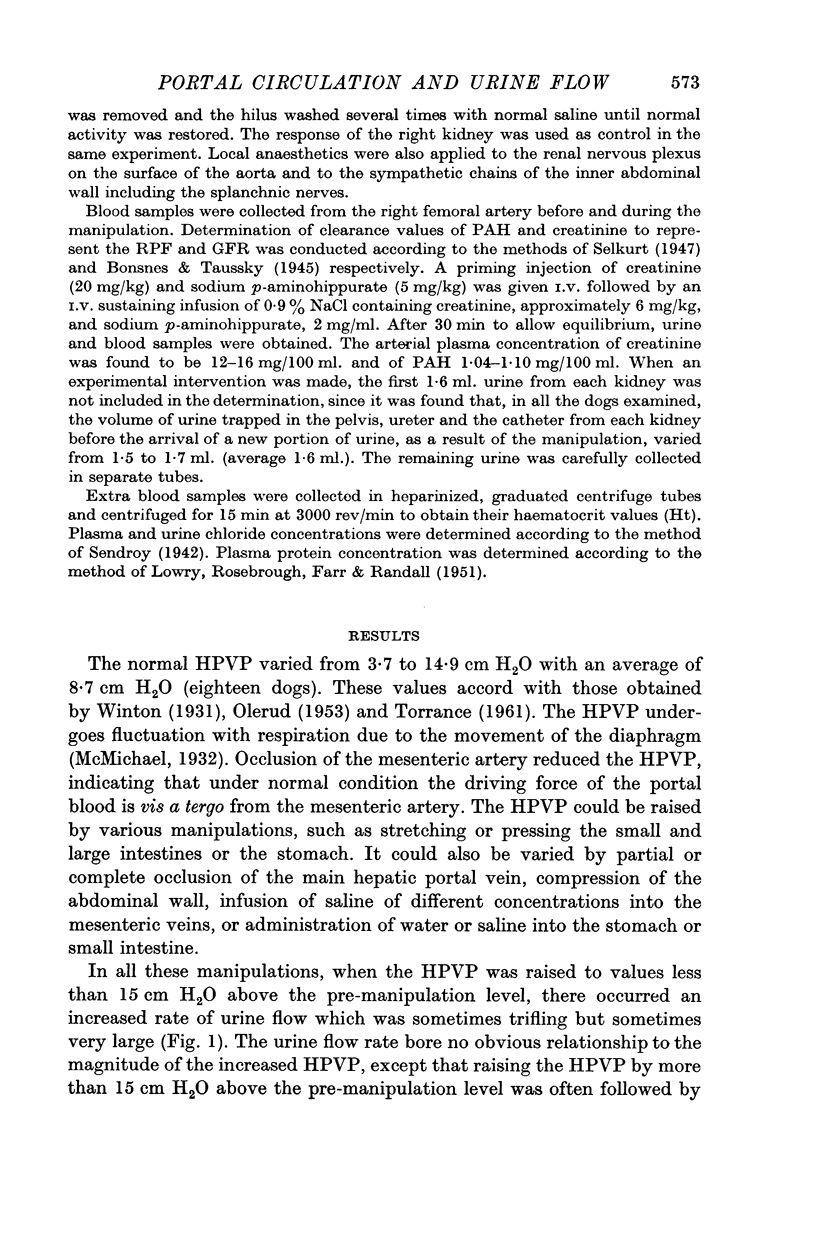
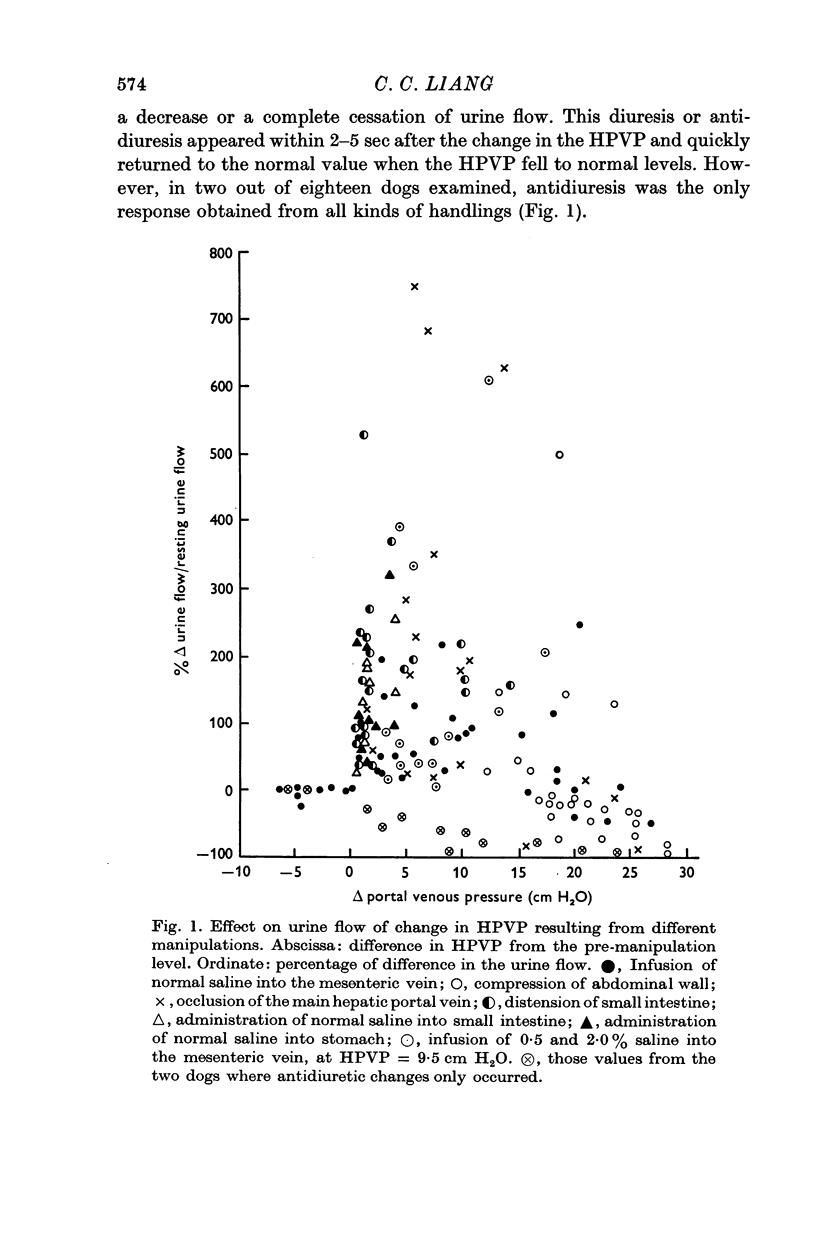
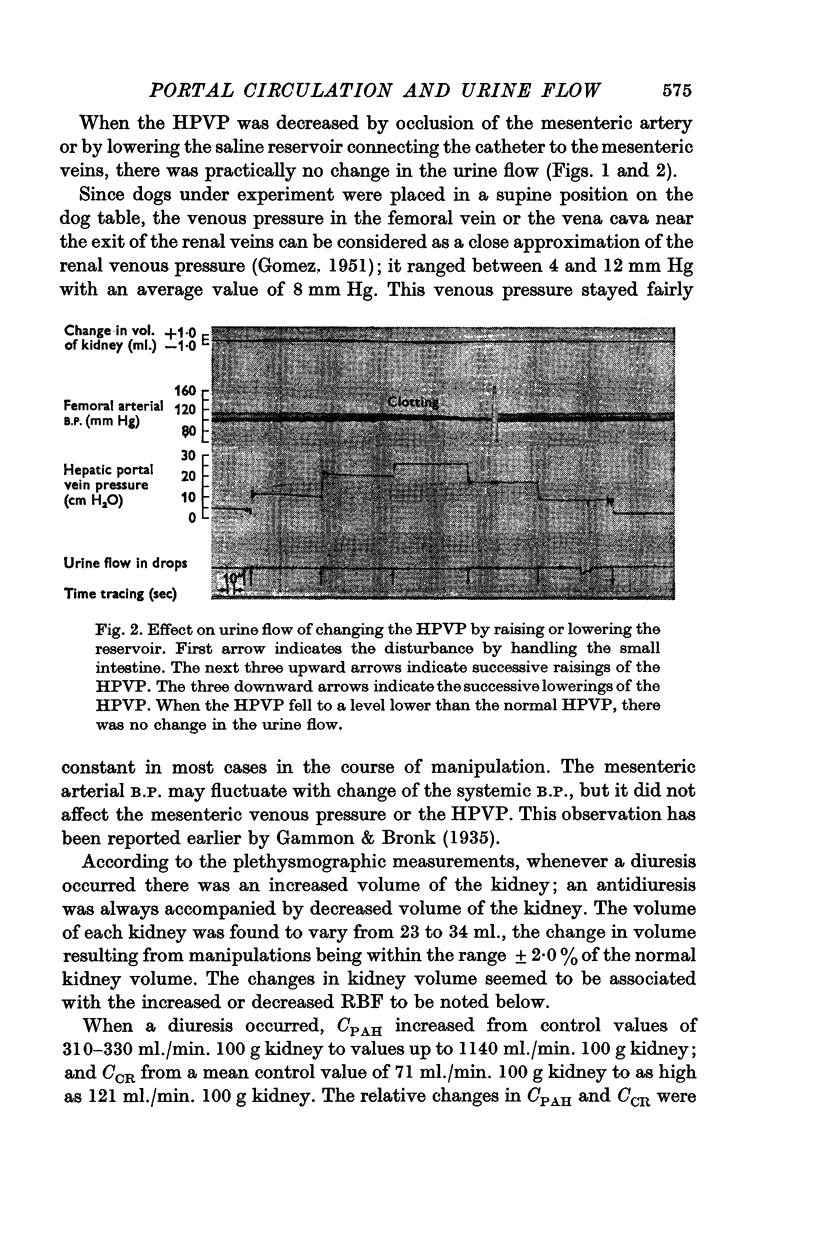
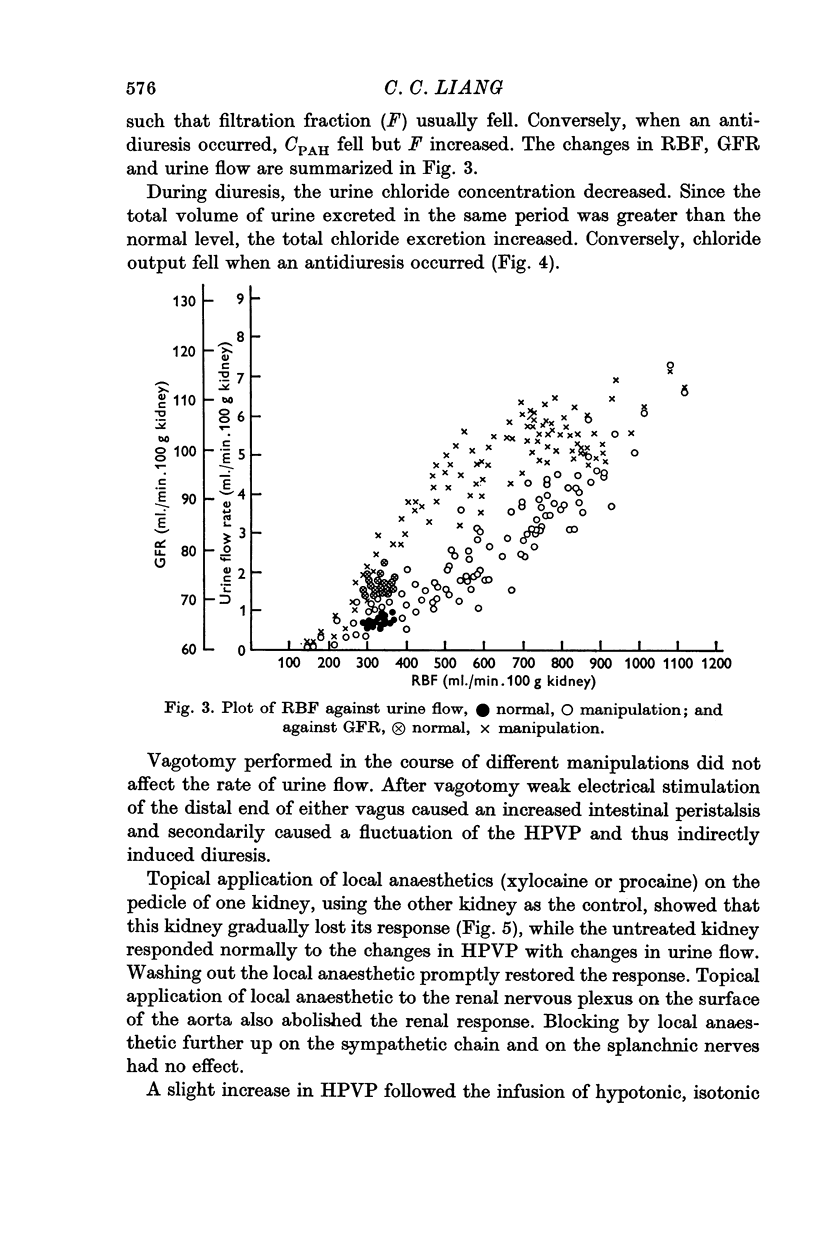


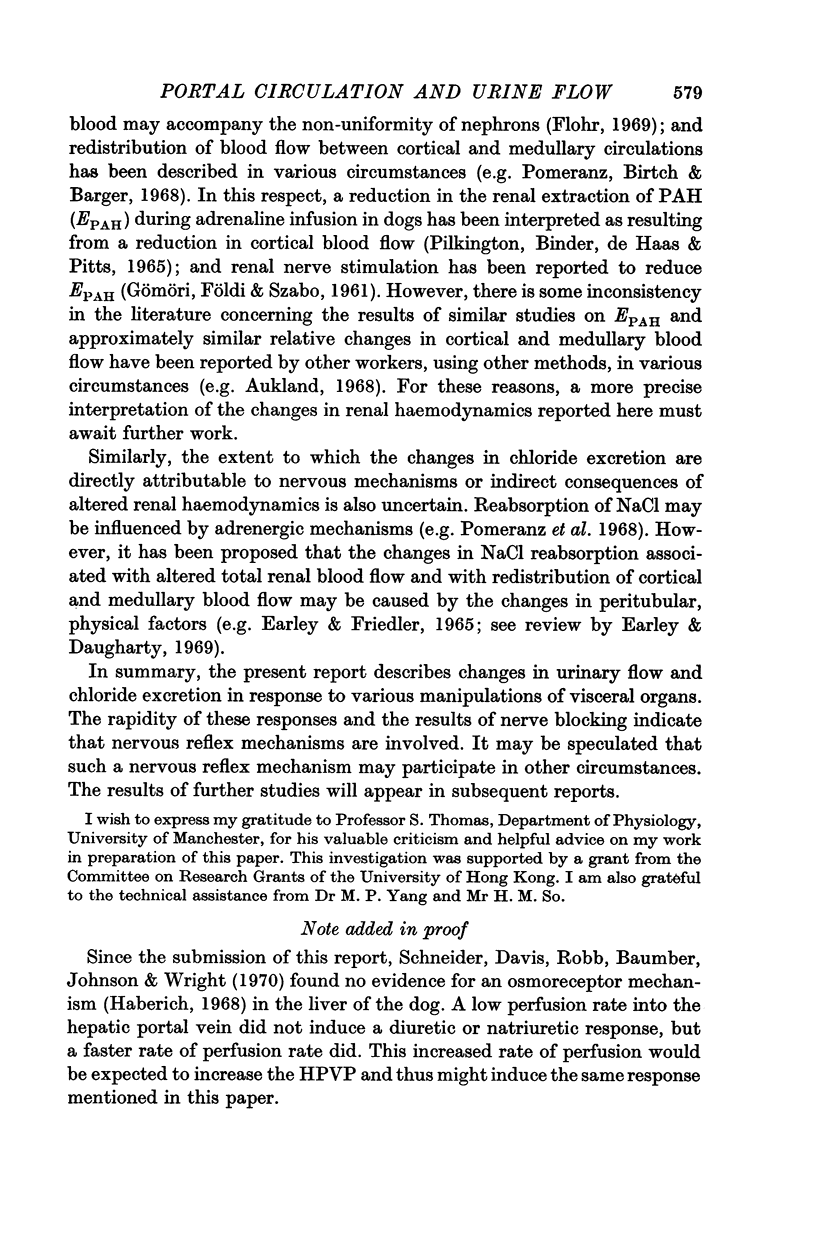


Images in this article
Selected References
These references are in PubMed. This may not be the complete list of references from this article.
- Aukland K. Effect of adrenaline, noradrenaline, angiotensin and renal nerve stimulation on intrarenal distribution of blood flow in dogs. Acta Physiol Scand. 1968 Apr;72(4):498–509. doi: 10.1111/j.1748-1716.1968.tb03874.x. [DOI] [PubMed] [Google Scholar]
- Earley L. E., Daugharty T. M. Sodium metabolism. N Engl J Med. 1969 Jul 10;281(2):72–86. doi: 10.1056/NEJM196907102810205. [DOI] [PubMed] [Google Scholar]
- Earley L. E., Friedler R. M. Studies on the mechanism of natriuresis accompanying increased renal blood flow and its role in the renal response to extracellular volume expansion. J Clin Invest. 1965 Nov;44(11):1857–1865. doi: 10.1172/JCI105293. [DOI] [PMC free article] [PubMed] [Google Scholar]
- Flohr H. Regional distribution of blood flow in the renal cortex. Experientia. 1969;25(7):779–780. doi: 10.1007/BF01897629. [DOI] [PubMed] [Google Scholar]
- GOMEZ D. M. Evaluation of renal resistances, with special reference to changes in essential hypertension. J Clin Invest. 1951 Oct;30(10):1143–1155. doi: 10.1172/JCI102534. [DOI] [PMC free article] [PubMed] [Google Scholar]
- GOMORI P., FOLDI M., SZABO G. Renal function in the case of renal arterio-venous shunt formation. Acta Med Acad Sci Hung. 1961;17:99–104. [PubMed] [Google Scholar]
- Haberich F. J. Osmoreception in the portal circulation. Fed Proc. 1968 Sep-Oct;27(5):1137–1141. [PubMed] [Google Scholar]
- LOWRY O. H., ROSEBROUGH N. J., FARR A. L., RANDALL R. J. Protein measurement with the Folin phenol reagent. J Biol Chem. 1951 Nov;193(1):265–275. [PubMed] [Google Scholar]
- MILIES E. A new diuretic factor of hepatic origin. Acta Physiol Lat Am. 1960;10:178–193. [PubMed] [Google Scholar]
- MITCHELL G. A. G. The renal nerves. Br J Urol. 1950 Dec;22(4):269–280. doi: 10.1111/j.1464-410x.1950.tb02537.x. [DOI] [PubMed] [Google Scholar]
- McMichael J. The portal circulation: I. The action of adrenaline and pituitary pressor extract. J Physiol. 1932 Jun 21;75(2):241–263. doi: 10.1113/jphysiol.1932.sp002888. [DOI] [PMC free article] [PubMed] [Google Scholar]
- Ohm W., Haberich F. J. Uber den Einfluss des Druckes im Portalkreislauf auf die Diurese der wachen Ratte. Pflugers Arch. 1969;306(3):227–231. doi: 10.1007/BF00592434. [DOI] [PubMed] [Google Scholar]
- PILKINGTON L. A., BINDER R., DEHAAS J. C., PITTS R. F. INTRARENAL DISTRIBUTION OF BLOOD FLOW. Am J Physiol. 1965 Jun;208:1107–1113. doi: 10.1152/ajplegacy.1965.208.6.1107. [DOI] [PubMed] [Google Scholar]
- Pomeranz B. H., Birtch A. G., Barger A. C. Neural contrfl of intrarenal blood flow. Am J Physiol. 1968 Nov;215(5):1067–1081. doi: 10.1152/ajplegacy.1968.215.5.1067. [DOI] [PubMed] [Google Scholar]
- Schneider E. G., Davis J. O., Robb C. A., Baumber J. S., Johnson J. A., Wright F. S. Lack of evidence for a hepatic osmoreceptor mechanism in conscious dogs. Am J Physiol. 1970 Jan;218(1):42–45. doi: 10.1152/ajplegacy.1970.218.1.42. [DOI] [PubMed] [Google Scholar]
- THURAU K. RENAL HEMODYNAMICS. Am J Med. 1964 May;36:698–719. doi: 10.1016/0002-9343(64)90181-0. [DOI] [PubMed] [Google Scholar]
- TORRANCE H. B. The control of the hepatic arterial circulation. J Physiol. 1961 Sep;158:39–49. doi: 10.1113/jphysiol.1961.sp006752. [DOI] [PMC free article] [PubMed] [Google Scholar]



